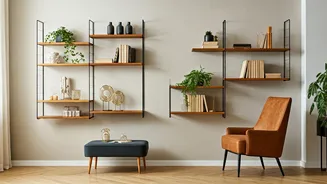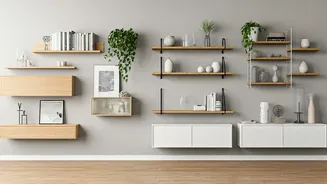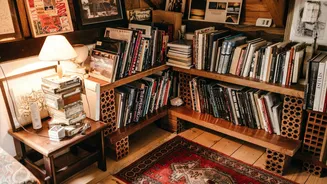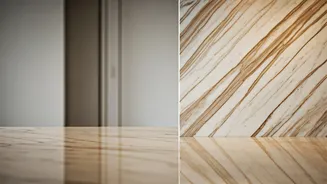Shelving: An Introduction
Wall shelves have become a versatile and stylish element in interior design, providing both storage and aesthetic appeal. They are an excellent way to declutter
spaces while also displaying decorative items like photographs, plants, and art. Shelves come in a range of designs and materials, catering to diverse tastes and needs. Their adaptability allows them to be incorporated into various rooms, whether it's the living room, bedroom, kitchen, or even the bathroom. From simple floating shelves to elaborate corner units, the options are extensive, ensuring there's a perfect fit for every home and style preference. Choosing the right wall shelves requires considering factors like available space, the items you wish to display, and the overall design scheme of your home to ensure they complement the existing decor seamlessly.
Floating Shelves: Sleek Design
Floating shelves are a popular choice due to their minimalist and modern aesthetic. These shelves appear to 'float' on the wall without visible brackets, creating a clean and uncluttered look. They are usually made from wood, MDF (Medium Density Fiberboard), or sometimes metal or glass, providing flexibility in terms of style and finish. Floating shelves are ideal for displaying decorative items, books, and small plants. They work well in living rooms, bedrooms, and even bathrooms. Because of their unobtrusive design, they can be placed in smaller spaces without making the area feel crowded. Installation is often straightforward, and they can be customized to suit different lengths and depths, making them a versatile option for any home.
Corner Shelves: Maximize Space
Corner shelves offer a practical solution for utilizing often-underused corner spaces. Designed to fit snugly into the angles of a room, these shelves maximize storage and display capacity in areas that might otherwise go to waste. They come in various shapes and sizes, from triangular designs that fit neatly into a single corner to multi-tiered units that provide ample storage. Corner shelves are particularly useful in bathrooms for storing toiletries, in kitchens for displaying cookbooks or spices, or in living rooms for holding decorative items or plants. They are typically made from materials like wood, metal, or plastic, ensuring they are durable and able to withstand the weight of various items. By using corner shelves, homeowners can improve their storage solutions and give their home a more organized look, making the most of every square inch.
Material Matters: Choice
The material of your wall shelves significantly impacts their aesthetic and durability. Wood shelves offer a classic and warm look, easily blending with various interior styles, from traditional to contemporary. They are sturdy and can support heavier items, such as books and decorative objects. Metal shelves provide a more modern and industrial vibe, often being chosen for their durability and sleek appearance. Metal shelves are a great fit in kitchens and bathrooms, as they can handle moisture and heavy use. Glass shelves give a light and airy feel, ideal for smaller spaces where you want to maintain a sense of openness. These shelves are elegant but can be more prone to showing fingerprints and require careful handling. The material choice should also complement the overall interior design, ensuring the shelves blend seamlessly with the room's decor.
Installation: Simple Steps
Installing wall shelves, while often manageable, requires a systematic approach to ensure safety and stability. The process typically begins with marking the desired positions on the wall using a level to guarantee the shelves are straight. Depending on the type of shelf and wall material, you may need to use a stud finder to locate studs for secure anchoring, especially when dealing with heavier loads. For drywall, you'll need appropriate wall anchors, which provide additional support and prevent the shelves from pulling away from the wall. Drilling pilot holes before inserting screws is a good practice to prevent the wood from splitting. Always follow the manufacturer's instructions for the specific shelves you're installing. Remember to double-check measurements and ensure the shelves are securely mounted to support the items you plan to place on them. If you are not comfortable, consider consulting a professional to ensure safe installation.
Shelves: Styling Tips
Styling wall shelves requires a keen eye for aesthetics, balancing functionality with visual appeal. Consider the items you want to display and arrange them in a way that creates visual balance. Grouping similar items together, such as a collection of books or a set of decorative vases, can provide a cohesive look. Introduce varying heights and textures to create visual interest. Combine items of different sizes, shapes, and materials to prevent the shelves from looking monotonous. Avoid overcrowding; leaving some empty space can add to the elegance. Use a variety of decorative objects, such as plants, artwork, and personal mementos, to reflect your personality. Regularly changing the items on your shelves can refresh the look of your space, keeping it dynamic and engaging.













